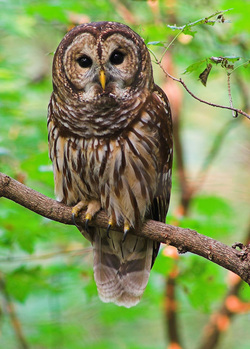Barred Owl (Strix varia)

Description: The Barred Owl is a gray-brown owl streaked with white barring on the chest
and belly. Their eyes are brown and they
have a yellow beak which is almost entirely enveloped with feathers. They are round-headed and have a dark brown
back spotted with white. Most Barred
Owls are medium-sized and have a very long brown tail. The females and males look very similar;
however, the females are slightly larger than the males. (Males tend to be
17-20 inches long while females are 20-24).
Habitat: Barred Owls tend to live in deep forests and woodlands near swamps or water sources. They are often found near creeks, lakes, rivers, and lakes in very mature woods. The typical habitat for Barred Owls should include conifers or deciduous trees for roosts throughout they year. The large trees also are ideal for nesting.
Diet: Barred Owls have a very multifarious diet. Their main prey consists of meadow voles, shrews, and deer mice. Other mammals such as squirrels, rabbits, opossums, and weasels are also food sources for the owls. In addition to mammals, the Barred Owls consume beetles, turtles, frogs, snakes, and lizards. On occasion, they eat birds such as woodpeckers, quail, blackbirds, and pigeons! They tend to devour their prey on the spot.
Behaviors:
Miscellaneous:
Habitat: Barred Owls tend to live in deep forests and woodlands near swamps or water sources. They are often found near creeks, lakes, rivers, and lakes in very mature woods. The typical habitat for Barred Owls should include conifers or deciduous trees for roosts throughout they year. The large trees also are ideal for nesting.
Diet: Barred Owls have a very multifarious diet. Their main prey consists of meadow voles, shrews, and deer mice. Other mammals such as squirrels, rabbits, opossums, and weasels are also food sources for the owls. In addition to mammals, the Barred Owls consume beetles, turtles, frogs, snakes, and lizards. On occasion, they eat birds such as woodpeckers, quail, blackbirds, and pigeons! They tend to devour their prey on the spot.
Behaviors:
- The owls frequently use perches, from which they then dive upon their prey. In order to catch frogs, other amphibians, and fish, the Barred Owl swoops down to the water’s edge.
- The owls are monogamous and breed for life
- They do not tend to migrate based on weather; nonetheless, they may migrate to find alternative food sources
Miscellaneous:
- The Barred Owl is very vocal, giving a loud call often described by the phrase, “Who cooks for you? Who cooks for you, all?”
- Most Barred Owl deaths are linked to humans, not other wild animals.
- They usually lay 2 to 4 eggs at a time.

